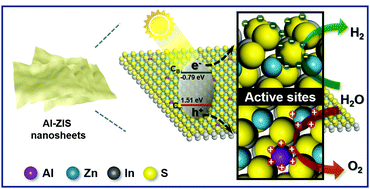Heteroatom-induced domain electrostatic potential difference in ZnIn2S4 nanosheets for efficient charge separation and boosted photocatalytic overall water splitting†
Abstract
Visible-light-driven photocatalytic overall pure water splitting is still a challenge, especially with single-component photocatalysts. Herein, ultrathin ZnIn2S4 nanosheets with Al doping (Al-ZIS) were fabricated via a one-step solvothermal method with magnetic stirring and could realize stoichiometric H2 and O2 evolution in pure water. The introduction of Al atoms not only adjusted the electronic configuration and improved the carrier density of atomic layers but also accelerated the separation efficiency of photogenerated charge carriers due to the formation of a domain electrostatic potential difference. Moreover, the positive charge enriched Al atoms are favorable for the adsorption of H2O molecules, which greatly boost the oxygen evolution reaction (OER) process on the Al-ZIS nanosheets. As a result, the photocatalysts achieved average H2 and O2 evolution rates of 77.2 and 35.3 μmol g−1 h−1, respectively, under visible-light irradiation and an apparent quantum yield (AQE) of 1.61% at 420 nm. This study provides new insights for introducing a heteroatom strategy to prepare other high-performance single-component photocatalysts for overall water splitting.



 Please wait while we load your content...
Please wait while we load your content...